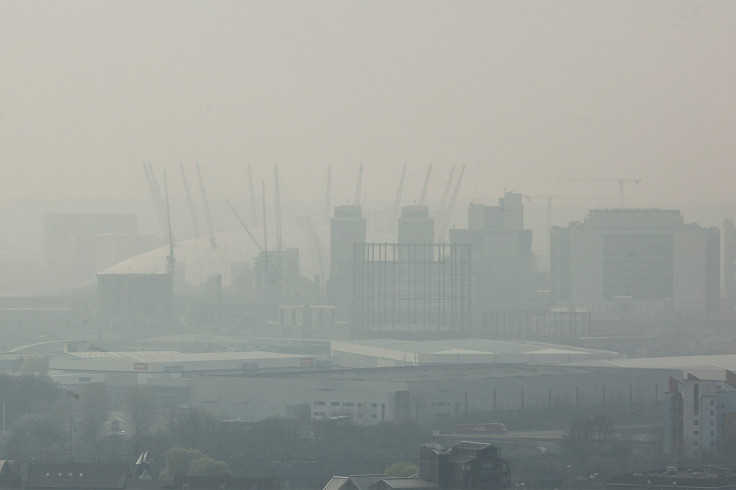UK weather: Why are Saharan dust clouds coming to England and are there any benefits?
The government has warned a Saharan dust cloud may cover London and other parts of England on Thursday 17 December, raising the pollution level to "high". The forecast comes after the Met Office began expanding its study of dust clouds arriving from west and north Africa in 2011, by issuing five-day forecasts.
But what causes the dust clouds? And are there any benefits? IBTimesUK takes a look behind this peculiar weather phenomenon...
What is Sahara dust?
When strong winds blow over the Sahara desert, they whip up dust and sand to what can be very high altitudes. The dust, combined with the extremely hot, dry air of the Sahara, often forms an atmospheric layer called the Saharan Air Layer where dust clouds are then carried by air currents through the upper atmosphere.
Winds usually have to be 20mph or stronger on the ground to cause the phenomenon. When gusts are strong enough, resulting clouds can be viewed from space.
How does it get to the UK?
Dust clouds from the Sahara can travel for thousands of miles, with an estimated 20,000 tonnes of deposits reaching as far as the Amazon rainforest every year.
They make the 2,000-mile journey to the UK having travelled across mainland Europe, propelled by southern winds. While the dust can hang in the air and cause a smog-like blanket – as seen in April last year when London was covered in a Saharan dust cloud – it often reaches the ground when rain droplets form and combine with the dust particles on the way down. This creates what is commonly referred to as "blood rain", which when it evaporates can leave behind a rusty brown residue, as happened last year when Londoners awoke to find their cars covered in a layer of dust.

Is it dangerous?
In certain weather situations, Saharan dust can seriously affect air quality and pollution levels. Dust and sand particles are left in the air which, when inhaled, can cause health problems, including itchy eyes, running noses, coughs and sore throats. People with pre-existing conditions like heart and lung problems are at far higher risk.
During previous dust clouds, the UK government advised vulnerable people, including the elderly, to stay indoors and reduce physical exertion. Last year's dust cloud saw a spike in the number of 999 calls from people experience breathing difficulties, with health officials warning asthma sufferers to carry their inhalers at all times.
Severe dust storms in other parts of the world have been linked to outbreaks of meningitis left in their wake across Africa.

How often does it happen?
In 2011, the Met Office extended its dust storm forecasting capability to give global coverage, and to extend forecasts to five days. Paul Hutcheon, Met Office forecaster, said the phenomenon usually happens in the UK several times a year "when big dust storms in the Sahara coincide with southerly winds". The transportation of Saharan dust into Europe often follows seasons, being more frequent from February to June, and from late autumn to early winter.
The Mediterranean region and parts of southern Europe are more frequently affected than the UK.
Due to the trade winds, a regular stream of dust-filled air from the Sahara also travels west across the Atlantic. As a result, people living in the Canary Islands off the west coast of Africa often experience what is known as the "Calima", from the Spanish word meaning "haze", which sees plumes of dust blown across the islands. This can reduce visibility to almost nil and leave everything exposed covered in a layer of dust.

Are there benefits?
While much UK media coverage of Saharan dust clouds tends to concentrate on the disruption caused to the country's cities and damage done to people's health, it does play a positive part in the wider world's environment.
The Amazon is effectively fertilised by the 20,000 tonnes of Sahara dust estimated to be deposited across the rainforest every year, according to a recent study. The sand is rich in phosphorus and provides plants with nutrients.
Scientists have also discovered large parts of the north Atlantic are reliant on the significant amounts of Saharan dust deposited in the ocean every year. They found grow in these regions only because they are able to take advantage of iron minerals found in Saharan dust. Research focusing on the Mediterranean Sea produced similar findings, with Saharan dust making up the major source of nutrients for phytoplankton and other aquatic organisms.
Another potential but little-known benefit is the effect it has on reducing the risk of hurricanes. Research by Nasa found evidence suggesting the chilling effect of dust clouds over the north Atlantic was responsible for one-third of the drop in sea surface temperatures between June 2005 and 2006. Scientists said this may have contributed to the difference in hurricane activity, which is fuelled by warmer sea temperatures, between the two years. In 2006, sea surface temperatures remained relatively cool and saw only five hurricanes, compared to 15 hurricanes in 2005 when the ocean surface was warmer.
However, Saharan dust has been associated with coral decline in the Caribbean. Bacteria carried in the particles are thought to cause Sea Fan disease, killing coral.

What is expected to happen this week?
Defra said in its outlook forecast: "There is a risk of moderate or high levels of air pollution across parts of southern and eastern England on Thursday due to Saharan dust, although large uncertainties remain as dust has yet to be observed lifting into the atmosphere from the likely source region in west Africa."

© Copyright IBTimes 2025. All rights reserved.






















